Major Research 1B Research on Mitigation and Restoration of Tsunami Disasters
Background and Objectives
Since the Great East Japan Earthquake in 2011, we have developed stable structures against tsunami with overflowing and a numerical simulation model to predict the drifting of debris generated by the destruction of structures. However, complex behaviors of running-up tsunami on land, and the resulting damages are not fully cleared, and then the predicting methods yet. In addition, regarding a technique for inundation real-time forecast, which is expected to be utilized for evacuation and other purposes, only data from GPS wave buoys is used; other valuable data is not fully utilized yet. In order to switch from a damage-first approach to a countermeasure-first approach to disaster prevention and mitigation, we will conduct research on the establishment of a resilient coastal zone, i.e., one that can protect human lives against the largest tsunami, prevent catastrophic damage to the social economy, and enable early restoration and recovery from the disaster.
Research Topics
As our research and development on tsunami mitigation and restoration, the following R&D activities will be conducted.
For our research on simulation model for tsunami drift object, we are examining the accuracy of 3-D simulation model of the behavior of drift object.
In the research and development of early inundation damage predicting technology for huge tsunami disasters with wide-area crustal deformation, our team is developing a new calculation method to make more efficient crustal deformation prediction, and to confirm the improvement of the prediction accuracy of tsunami waveforms.
In a study to develop a large-scale numerical wave tank for a group of outer facilities, in addition to improving the accuracy of the particle method model, develop a pre-post GUI and implement an automatic continuous calculation function for large amount calculations.
For our study on the effects of tsunami wave force on mangroves and their deformation, we are analyzing the results of hydraulic model experiments conducted the previous year and conducting studies on mangrove roots based on literature and also in the field.For our research on simulation model for tsunami drift object, we are examining the accuracy of developing 3-D simulation model for the behavior of drift object.
Activities in FY 2021
We improved the 3-D drift object simulation model that had been developed by the previous year and verified its effectiveness by comparing with experimental results. In addition, we established the local contact model of drift object for the planar 2-D simulation model, and confirmed the effectiveness by comparing with experimental results.
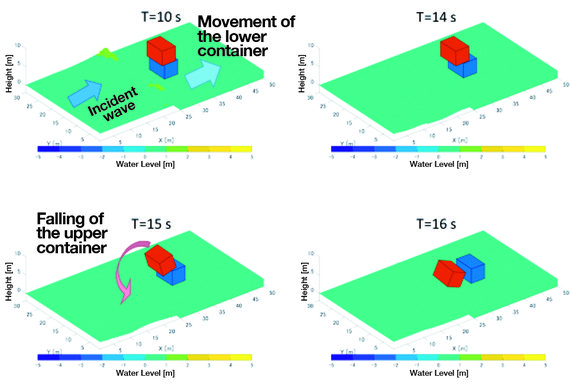
Numerical simulation by 3-D model
Estimation of earthquake fault planes is essential for estimating crustal deformation, however, there was no efficient way to estimate this from tsunami waveforms. Therefore, we developed an adjoint waveform synthesis method that can instantly evaluate the tsunami waveform at any observation point. The conventional method requires the assumption of a fault plane in advance, and its estimation accuracy is reduced when an earthquake different from the assumed one occurs. The newly developed method can synthesize tsunami waveforms generated from arbitrary wave sources, thereby improving accuracy of tsunami waveform estimation. We applied this method to the tsunami caused by the 2012 Haida Gwaii earthquake, and it is clear that the method improves prediction performance in terms of both rapidity and accuracy.
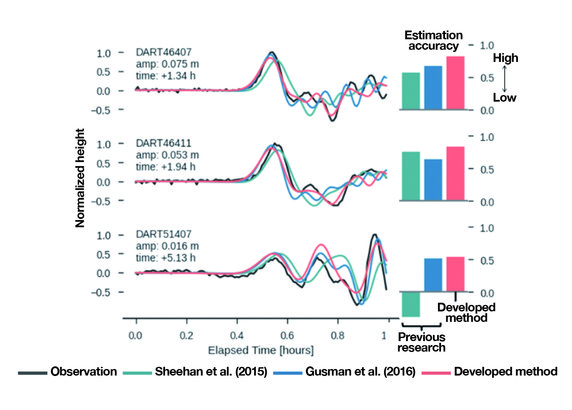
Observed tsunami waveforms resulting from the 2012 Haida Gwaii earthquake, comparative
waveforms simulated by different methods, and their estimation accuracy
We developed a particle- based numerical wave tank and a GUI to accurately and stably handle fluid motions for complex topography. Moreover, pressure calculations and water surface boundary conditions of impact water by improving the accuracy of numerical noise of impact water was improved. Furthermore, we tested anti-scour measures through the developed numerical wave tank to examine their applicability to the breakwaters of actual ports in major tsunami events.
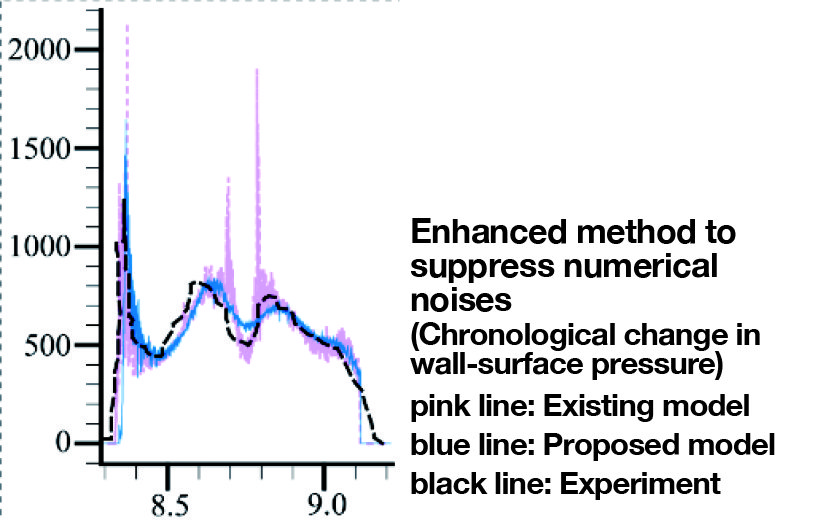
Numerical noise improvement achieved by adjusting the model
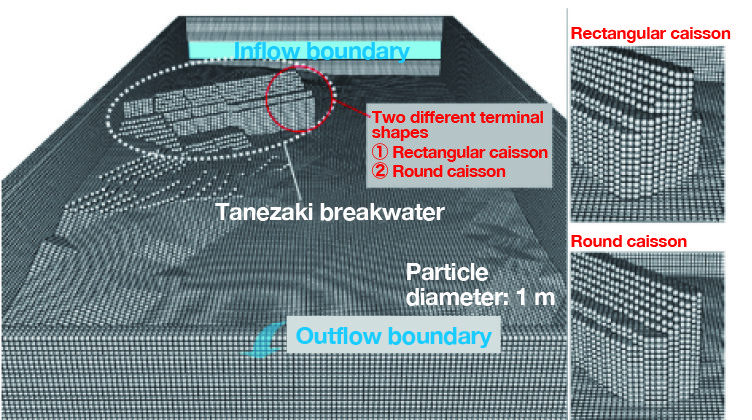
Mesh created on the GUI representing the end of the breakwater
As mangroves have numerous roots penetrating the soil, they are highly resistant to tsunami. To elucidate such characteristics of mangroves, we studied and analyzed their behavior under the impact of tsunami in the hydraulic model experiment conducted the previous year. Furthermore, to investigate the tsunami-resisting capability of mangrove roots, we traveled to a mangrove habitat and surveyed the soil characteristics including sand particle size.
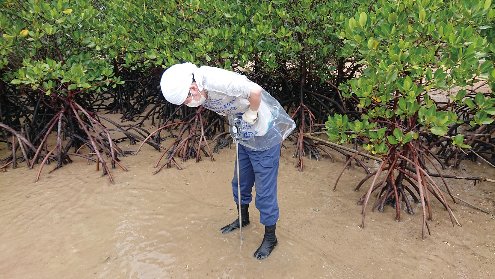
Ground survey near mangrove trees



